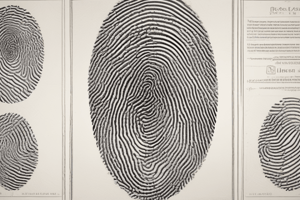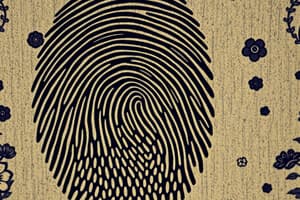Podcast
Questions and Answers
What is a Plain Arch?
What is a Plain Arch?
- A loop pointing towards the thumb.
- Friction ridges enter on one side of the impression and flow out the other side with a rise or wave in the center. (correct)
- A fingerprint pattern resembling small whirlpools.
- A single friction ridge that terminates within the friction ridge structure.
What are Whorls in fingerprint patterns?
What are Whorls in fingerprint patterns?
Fingerprint patterns that resemble small whirlpools revolving around a point.
What does a Radial Loop point towards?
What does a Radial Loop point towards?
The thumb.
What are Type Lines?
What are Type Lines?
What is Divergence in fingerprint terminology?
What is Divergence in fingerprint terminology?
Define Short Ridge.
Define Short Ridge.
What is the core of a fingerprint?
What is the core of a fingerprint?
What are the Shoulders of Ridge?
What are the Shoulders of Ridge?
An Upthrust is an ending ridge rising at a sufficient degree from the horizontal plane.
An Upthrust is an ending ridge rising at a sufficient degree from the horizontal plane.
Describe a Plain Whorl.
Describe a Plain Whorl.
What is a Double Loop Whorl?
What is a Double Loop Whorl?
Define Whorl Tracing.
Define Whorl Tracing.
What are Recurving Ridges?
What are Recurving Ridges?
What is an Ending Ridge?
What is an Ending Ridge?
What is a Spiral Ridge?
What is a Spiral Ridge?
What do Loops consist of?
What do Loops consist of?
What direction does an Ulnar Loop open towards?
What direction does an Ulnar Loop open towards?
What constitutes the Pattern Area in fingerprints?
What constitutes the Pattern Area in fingerprints?
Define Bifurcation.
Define Bifurcation.
What is a Delta in fingerprint terms?
What is a Delta in fingerprint terms?
What is Ridge Ending?
What is Ridge Ending?
What is a Looping Ridge?
What is a Looping Ridge?
What is a Sufficient Re-Curve?
What is a Sufficient Re-Curve?
Define Ridge Count.
Define Ridge Count.
What is a Numerical Value in fingerprint analysis?
What is a Numerical Value in fingerprint analysis?
Describe a Central Pocket Loop.
Describe a Central Pocket Loop.
What defines an Accidental Whorl?
What defines an Accidental Whorl?
Study Notes
Fingerprint Patterns
- Plain Arch: Friction ridges enter on one side and exit on the other, featuring a rise or wave in the center.
- Whorls: Fingerprint patterns that resemble small whirlpools centered around a point.
- Radial Loop: Loop pointing towards the thumb.
- Ulnar Loop: Loop opens toward the little finger (ulna).
- Loops: Patterns with ridges that double back on themselves, making up about 65% of fingerprints.
Key Components of Fingerprints
- Type Lines: Two innermost friction ridges associated with a delta, which can parallel, diverge, or surround a pattern area.
- Core of Fingerprint: Central area in a fingerprint with potentially multiple cores; identified in whorl and loop patterns.
- Delta: Triangular-shaped pattern where multiple ridges meet, with one delta for loops and two for whorls.
- Pattern Area: Includes the core, delta, and surrounding ridges used for classification.
Fingerprint Features and Definitions
- Short Ridge: A single friction ridge that travels a short distance before ending.
- Ending Ridge: A friction ridge that terminates within the overall ridge structure.
- Appendages: Obstructions or features that can spoil the flow of a fingerprint pattern.
- Shoulder of Ridge: Points where the curve of a loop pattern turns inward.
Whorl Patterns
- Plain Whorl: Contains two deltas and at least one ridge making a complete circuit; resembles a bullseye.
- Double Loop Whorl: Comprises two separate loops with opposing openings.
- Central Pocket Loop: Has two deltas and one complete ridge circuit, with no recurving ridges touching a line drawn between the deltas.
- Accidental Whorl: A unique pattern made from combining two or more types, typically with two or more deltas.
Ridge Characteristics
- Bifurcation: The point where a ridge splits into two.
- Ridge Ending: The terminus of a ridge.
- Looping Ridge: Ridges that curl around the fingertip and flow in opposing directions.
- Recurving Ridges: Unique wave patterns in fingertip ridges used for individual identification.
Classification Concepts
- Ridge Count: The number of ridge lines crossed by a line drawn from the delta to the core, excluding these points themselves.
- Sufficient Re-Curve: The space between the shoulders of a loop without any appendages intersecting at a right angle.
Identifying Patterns
- Whorl Tracing: The process of following the ridges from the left delta to the right delta to classify as outer, meeting, or inner.
- Numerical Value: Symbols representing numbers used in various measurements or classifications.
Historical Context
- Fingerprints became a credible form of identification in the early 20th century, gaining acceptance in courts by demonstrating the uniqueness of each print through various means.
- The first conviction based solely on fingerprint evidence occurred in 1937 in New York, marking a significant milestone in forensic science.
Studying That Suits You
Use AI to generate personalized quizzes and flashcards to suit your learning preferences.
Description
This quiz focuses on the fundamental concepts of fingerprint patterns, including plain arches, whorls, and various loop types. Test your knowledge and understanding of forensic terminology related to fingerprint analysis. Perfect for students in criminal justice or forensic science courses.




